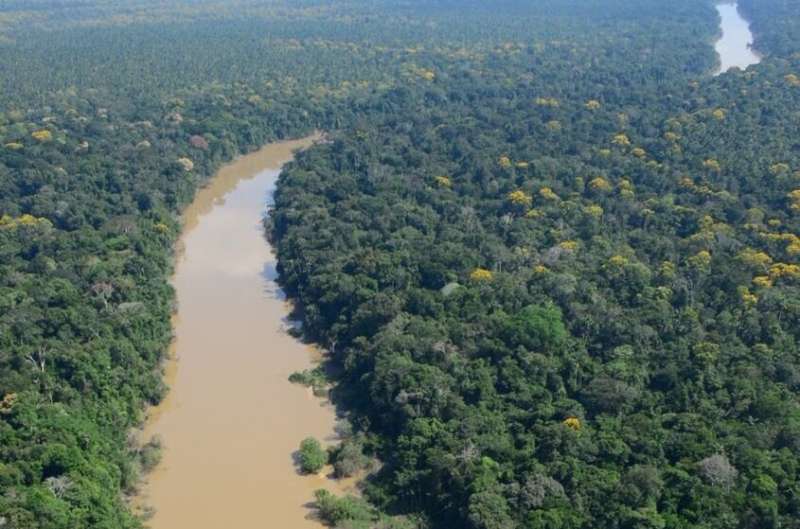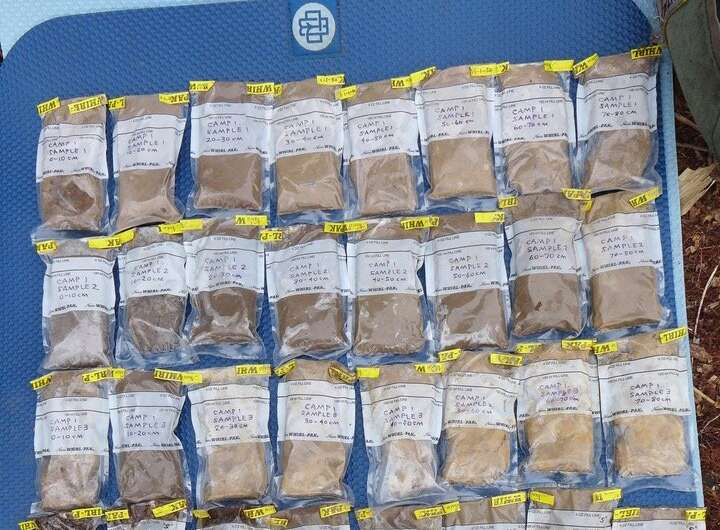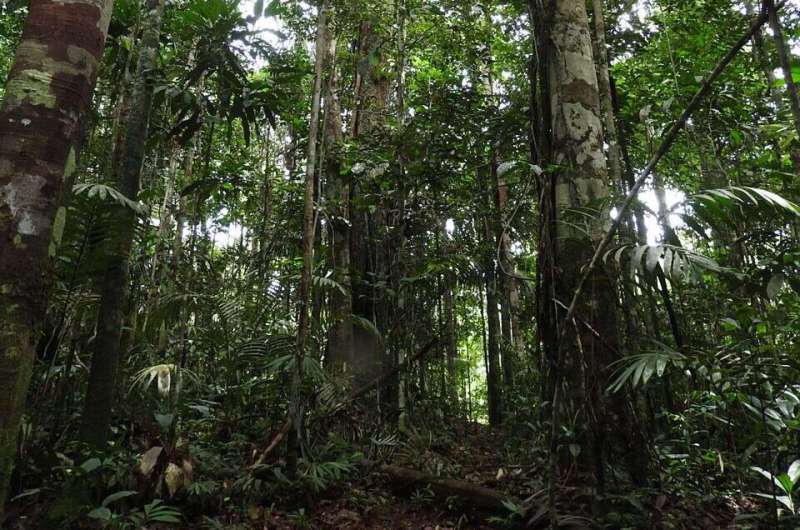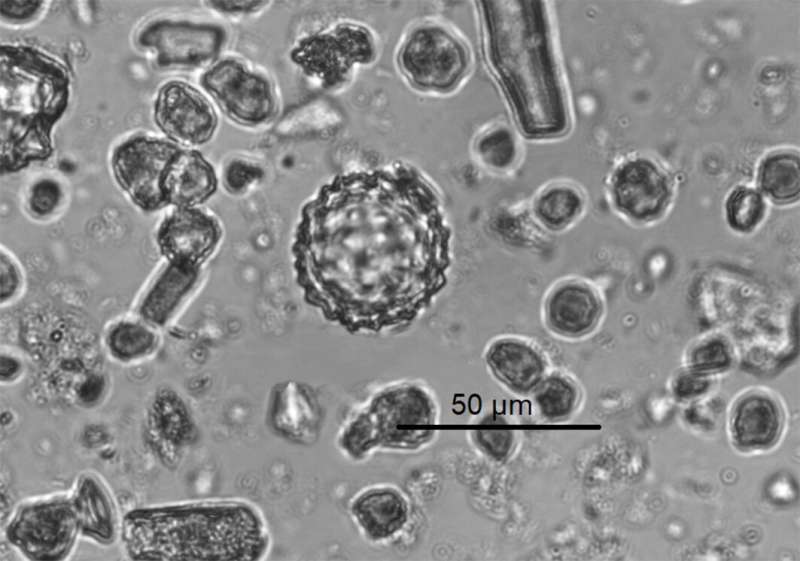Aerial view of the Putumayo region of the Amazon rainforest in Peru. Credit: Alvaro del Campo, Field Museum
We sometimes think of the Amazon rainforest as unaltered by humans, a peek into the planet's past. In recent years, scientists have learned that many parts of the Amazon aren't untouched at all—they've been cultivated by Indigenous peoples for thousands of years, and mere centuries ago were the sites of cities and farmland. But that's not the case everywhere. In a new study in PNAS, researchers determined that a rainforest in the Putumayo region of Peru has been home to relatively unaltered forest for 5,000 years, meaning that the people who have lived there found a long-term way to coexist with nature—and the evidence is in microscopic bits of silica and charcoal in the soil.
"It's very hard even for experienced ecologists to tell the difference between a 2,000-year-old forest and a 200-year-old forest," says Nigel Pitman, an ecologist at Chicago's Field Museum and a co-author of the PNAS paper. "There's more and more research showing that many Amazonian forests we think of as wilderness are actually only 500 years old, because that's when the people who were living there died from the pandemics brought by Europeans, and the forest has regrown."
"Far from implying that complex, permanent human settlements in Amazonia had no influence over the landscape in some regions, our study adds substantially more evidence indicating the bulk of the Indigenous population's serious impact on the forested environment was concentrated in the nutrient-rich soils near rivers, and that their use of the surrounding rainforest was sustainable, causing no detectable species losses or disturbances, over millennia," says Dolores Piperno, a researcher at the Smithsonian Tropical Research Institute and the study's first author.
Many plants take up silica from the soil and use it to produce microscopic mineral particles called phytoliths that provide structural support. After a plant dies, these phytoliths linger in the soil for thousands of years. Different kinds of plants produce differently-shaped phytoliths, meaning that phytoliths in the soil can be used to determine what kinds of plants lived there in the past.
For this study, Piperno and her colleague Crystal McMichael at the University of Amsterdam needed soil samples from the Putumayo region of the Amazon rainforest in northeastern Peru. That's where Pitman came in. In his work with the Field's Keller Science Action Center, Pitman takes part in "rapid inventories" of the Amazon, intensive information-gathering trips to document the plants and animals of a region and build relationships with the people who live there, in order to help build a case for protecting the area. Piperno and McMichael reached out to Pitman, a botanist, and asked if he'd be able to collect soil samples as he inventoried the Putumayo region's trees.
Soil samples collected in the rainforest. Credit: Nigel Pitman, Field Museum
"The three or four days that we're at one of these sites feel like running a marathon. We have to get a lot done in a really short amount of time, and so we're up really early, we stay up really late, and somehow these soil cores had to be taken at the same time," says Pitman. "Sometimes we collected the soil at midnight, or during rainstorms, when we couldn't survey trees."
To collect the soil, Pitman and his colleagues, including Field Museum associates Juan Ernesto Guevara Andino, Marcos Ríos Paredes, and Luis A. Torres Montenegro, used a tool called an auger. "It's a long metal pole with blades at the bottom, and when you stick it in the ground and rotate it, it carves out a column of soil about 2 to 3 feet long." The team took samples of the soil at different heights on the column, placed them in plastic bags, and transported them back to the US for analysis.
The soil's age roughly correlates to its depth, with newer soil at the top and older soil deeper within the earth. Back in the lab, the researchers used carbon dating to determine the soil's age and then painstakingly sorted through samples under a microscope, searching for phytoliths that would tell them what kinds of plants were living in the area at a given time.
They found that the types of trees growing in the region today have been growing there over the past 5,000 years—an indicator that unlike in other parts of the Amazon, the Putumayo wasn't home to cities and farmland prior to European colonization.
In addition to phytoliths, the researchers also looked for microscopic bits of charcoal. "In the western Amazon where it's wet year-round, finding charcoal tells you that people were there," says Pitman. "There aren't natural forest fires from lightning strikes, so if something burns, it's because a person set it on fire."
The Putumayo region of the Amazon rainforest in Peru, interior. Credit: (c) Corine Vriesendorp, Field Museum
The low levels of charcoal in the soil show that while the forest remained unaltered by humans for 5,000 years, people did live in the area—they just coexisted with the forest in a way that didn't change it.
"One of the scary things for conservationists about research showing that so much of the Amazon used to be towns and cropland, is that it's allowed people who aren't conservationists to say, 'If that was the case, then you conservationists are getting upset for no reason—500 years ago, half the Amazon was cut down and all grew back, it's no big deal. We don't have to worry so much about cutting down the Amazon, we've already done it and it turned out fine,'" says Pitman. This study suggests that while people are able to coexist with wilderness without altering it, the Amazon isn't simply a resource that can be destroyed and regrown from scratch in a matter of centuries.
Long-lasting microfossil particles of dead plants called phytoliths seen under a microscope, sampled from soil cores taken by scientists from the Amazon Basin. Most phytoliths studied by the team were smaller than the width of a human hair. Scientists used the soil cores to create timelines of plant life and fire history at each location going back some 5,000 years. To do this, the team extracted phytoliths and looked for traces of fire such as charcoal or soot. Fire, in a landscape that receives nearly 10 feet of rain annually, is nearly always human in origin and would have been instrumental in clearing large areas of land for human uses, such as agriculture and settlement.Smithsonian scientists and their collaborators have found new evidence that prehistoric Indigenous peoples did not significantly alter large swaths of forest ecosystems in the western Amazon, effectively preserving large areas of rainforests to be unmodified or used in sustainable ways that did not reshape their composition. The new findings are the latest in a long scientific debate about how people in the Amazon have historically shaped the rich biodiversity of the region and global climate systems, presenting new implications for how the Amazon's biodiversity and ecosystems can be best conserved and preserved today. Credit: Dolores Piperno, Smithsonian.
"To me, these findings don't say that the Indigenous population wasn't using the forest, just that they used it sustainably and didn't modify its species composition very much," says Piperno. "We saw no decreases in plant diversity over the time period we studied. This is a place where humans appear to have been a positive force on this landscape and its biodiversity over thousands of years."
"It's an important finding, and a hopeful one, because it shows that people have been living in the Amazon for thousands of years, in a way that allows them to thrive and the forest to to thrive," says Pitman. "And since this particular forest is still being protected by Indigenous peoples, I hope this study reminds us all how important it is to support their work."
More information: Dolores R. Piperno el al., "A 5,000-year vegetation and fire history for tierra firme forests in the Medio Putumayo-Algodón watersheds, northeastern Peru," PNAS (2021). www.pnas.org/cgi/doi/10.1073/pnas.2022213118
Journal information: Proceedings of the National Academy of Sciences
Provided by Field Museum



























